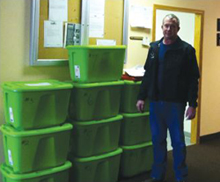Each community must assess both its strengths and limitations when generating an action plan for improving survival from sudden cardiac arrest. The following activities and steps to encourage community involvement have been successfully implemented across the country.
✓ Ensure that there is committed leadership with physician involvement.
- Physician leadership can bring together citizen, government, EMS system, and hospital stakeholders to ensure a comprehensive, iterative system for improving SCA survival.
✓ Measure and publicly report OHCA survival to hospital discharge rates annually.
- Continuous quality improvement efforts must be linked to clinical outcomes and reported accurately to the community.
✓ Educate community leaders and stakeholders about cardiac arrest survival in their community.
- This may be best accomplished in person. Go armed with fact sheetsemphasizing the details you want to be remembered.
- Visit stakeholders from local government, public safety, school systems, faith-based organizations, service organizations and businesses. Involve them in your efforts by harnessing the people-power they represent to provide education and training to their constituents.
✓ Obtain written commitment from local stakeholders to use toward building a true community partnership.
- Examples of “asks”:
- Generic letters of support for later use as documentation for funding or other support
- Letters of commitment to a particular activity, such as CPR/AED training
- Letters of commitment to a particular resource, such as the provision of space, advertising or public service announcements
- Community groups can raise funds to purchase and place AEDs in locations that matter to the community, such as a local church, a community sports field, or other community gathering place.
- Sports teams can sponsor mass CPR training events at their stadiums or arenas.
✓ Build a strong partnership with EMS leaders and providers in your community. Enlist EMS to assist in encouraging and providing CPR and AED training, and to assist in coordinating survivor events.
✓ Establish an annual survivor celebration event to honor the 911 call takers, EMS professionals, and bystanders who helped save a life.
- Survivors are generally interested in relating their stories. These events can bring survivors together and may stimulate the development of local advocacy and support groups among survivors.
- EMS Week during May is a popular time to hold these annual events, as is Heart Month in February.
- While the focus will be on the survivors over the preceding year, inviting survivors and families from previous years can help the event have greater impact.
✓ Involve and educate local celebrities who may help to serve as masters of ceremony for OHCA survivor celebrations and training events.
- Sports stars, local media personalities, and well-known community leaders have contributed in many cities.
✓ Establish a system/clearinghouse for handling requests for public appearances, training sessions, and media opportunities in your community.
✓ Establish a web presence with up-to-date national and local facts about OHCA that individuals (media, advocates, laypersons) can refer to for reliable information. Visit the website GallatinHeartRescue.com to view an excellent example. Be sure to include a training session calendar and links to related resources such as the Medtronic Foundation HeartRescue program.
✓ Create a local chapter of a national group of survivors such as the Sudden Cardiac Arrest Association.
- Local survivor chapter members can be powerful allies in advocacy. They can also help with survivor events and serve as a resource to “new” survivors.
✓ Train and empower local groups to provide CPR training. Facilitate their efforts by providing needed supplies, encouragement, support, and reporting of number of people trained.
Gallatin HeartRescue “CPR in a Box”
 Supplies needed at site:
Supplies needed at site:
- Equipment to project DVD picture and sound
- Projection screen (or wall)
- Floor space for participants to practice compressions
Each tote box contains:
- 10 inflatable manikins
- 2 CPR video DVDs
- Survivor DVD containing three survivor stories
- Bicycle pump to inflate manikins
- Cleaning wipes (can use alchohol wipes)
- Facilitator guide
- Instructor’s guide
- Participant log

